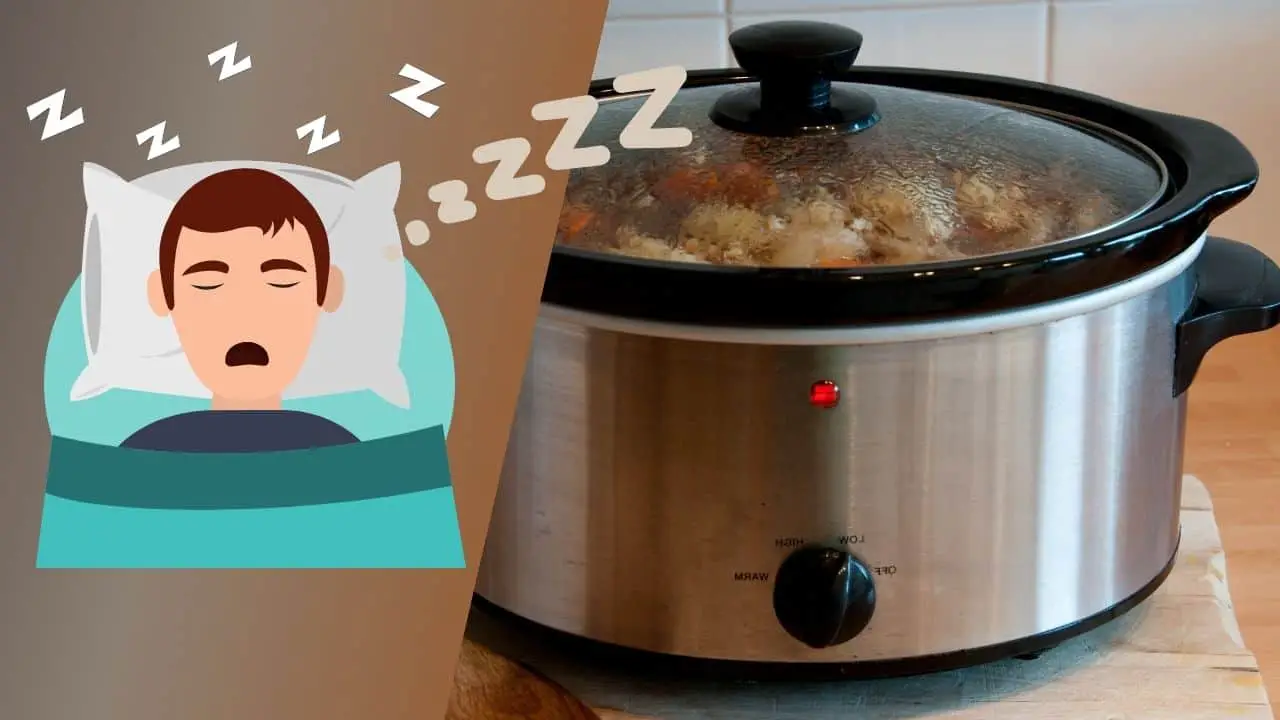Is it safe to leave your slow cooker on overnight? This question has puzzled home cooks and prompted debates. While the convenience of slow cooking is undeniable, safety should never be compromised when using your crock pot.
In this article, we’ll explore the essential safety guidelines for leaving your stew or any other food in the slow cooker overnight or even 24 hours; you’ll want to know before making your decision. Your peace of mind could depend on it.
So you’re curious if it’s safe to leave your slow cooker on all night, huh? Don’t miss the video below—it’s a quick watch that gives you the lowdown on everything we’re talking about in the article.
Ideally, you wouldn’t want your cooker running longer than the recipe requires, which is why some newer cookers come with a programmable timer. With the help of such timers, after set hours, it will automatically turn off or switch to a higher or lower temperature setting.
This is particularly useful if you plan to let your slow cooker run overnight, ensuring that it won’t operate longer than the recipe calls for.
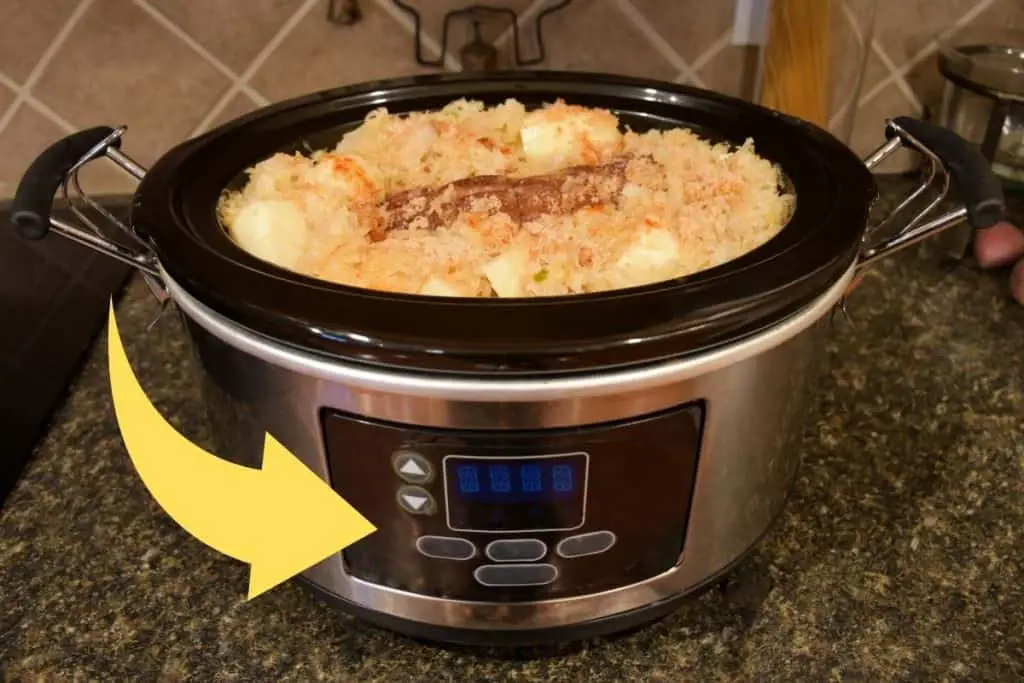
However, if you have a regular slow cooker with just four or five basic settings, Off, Low, High, Auto, and Warm, then accidentally leaving it on before going to work should not cause you much worry either.
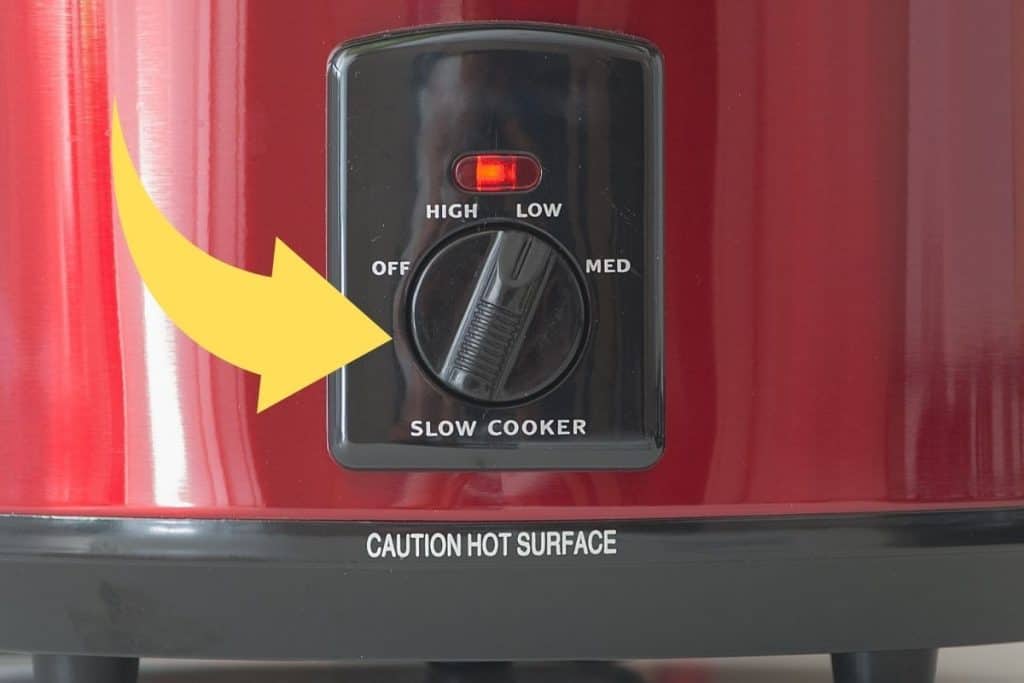
Your cooker can probably run longer than required without any considerable risk as long as you are using the appliance correctly.
Below, I have outlined essential safety recommendations and best practices for using your slow cooker or crock pot safely and effectively.
For How Long Can You Safely Leave Your Slow Cooker On?
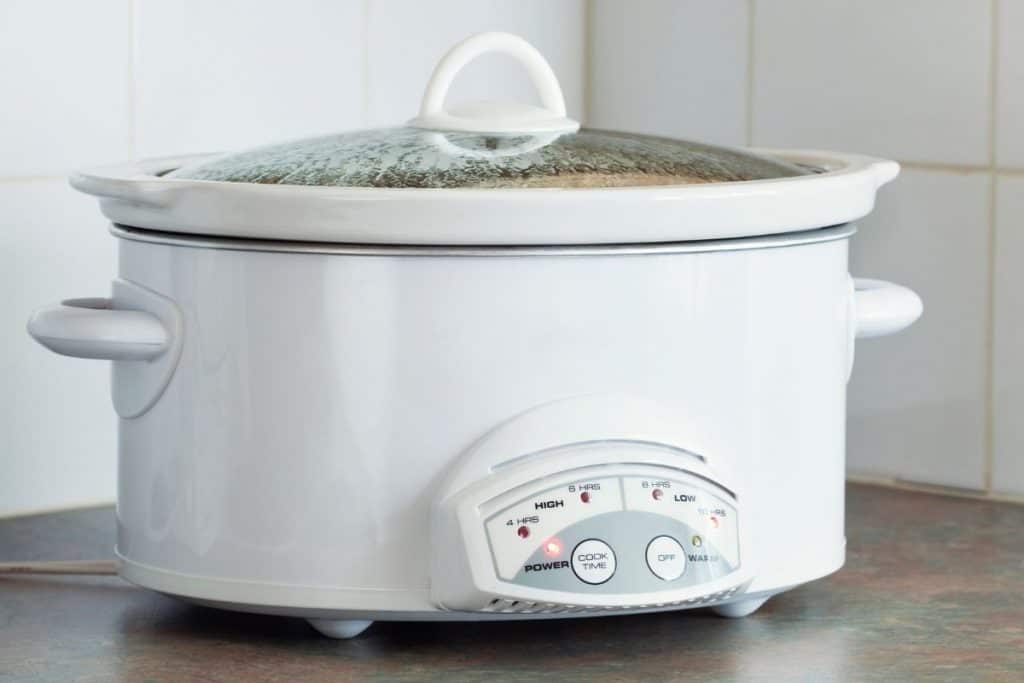
According to some slow cookers user manuals, while most cookers are completely fine to be left on for 24 hours or even longer, other models are only approved for no more than 12 hours of continuous running time.
It is always best to read the instructions for your new kitchen device before you start using it. Still, interestingly, most slow cooker user manuals don’t mention the recommended maximum continuous running time at all in their instructions.
From that, we could conclude that using a slow cooker without a break for hours or even days on end is not really a concern for most manufacturers because these appliances are built to withstand extra long cooking times.
So, when a slow cooker is left on for extended periods of time, your concerns shouldn’t be so much about the appliance itself but the food you are cooking in it.
If you are not entirely convinced that a slow cooker can be left on non-stop for hours or even days, check out how I made black garlic in a slow cooker while the device was left on for 40 days without a break.
Food Safety And Cooking Tips For The Slow Cooker
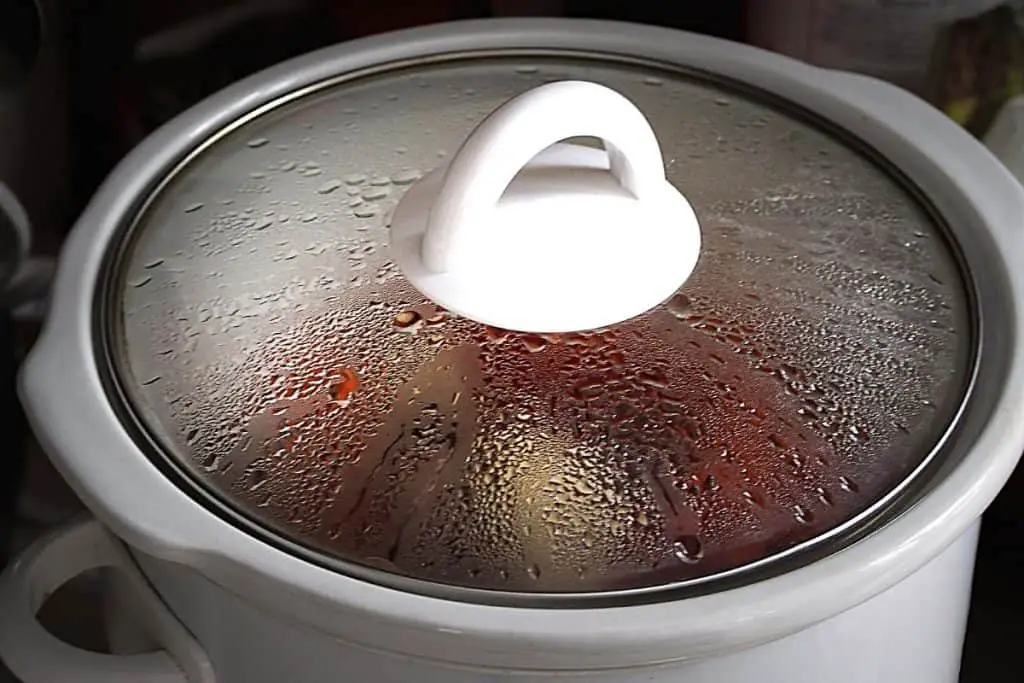
Naturally, suppose you’re running your slow cooker for many hours; in that case, you’d want to take specific added measures so that you can eliminate any unnecessary risks and make sure your meal recipe will turn out perfectly cooked.
Here’s a list of 14 things to keep in mind when using a slow cooker:
1. Ensure that your cooker is placed on a heat-proof surface
Try to avoid laminate or wooden tables or countertops because they might not be ultimately heat resistant. Also, wood and wood-based materials are natural insulators, meaning your appliance has a higher chance of overheating.
Ideally, the cooker should be placed on tiled, stone, stainless steel, or granite surfaces. To protect the table or countertop surface from heat and spills, place a trivet, hot pad, silicone baking mat, baking sheet, or protective padding underneath the cooker.
2. Keep it away from walls and at least 6 inches away from any other appliance
Slow cookers produce heat from the inside, so it is generally a good idea to keep them away from any other objects that can be damaged by the heat and block or contain vapor and heat emissions.
3. Don’t overload the cooker!
Overloading (and this is a common mistake) will cause your ingredients to overflow, and there’s a good chance that the liquid will go between the ceramic or porcelain pot and the outer casing and start to smoke.
As a good rule of thumb, fill the cooker one-half to three-quarters of the way with ingredients and leave the rest of the space empty.
4. Put the slowest cooking ingredients on the bottom or sides
Ingredients that cook the slowest, like some lentils or meat, should be placed near the heating element, at the bottom, or on the sides of the crockpot to allow more even cooking of all the ingredients.
6. Thaw poultry and meat products before cooking
Always thaw poultry and meat products in the refrigerator before putting them into a slow cooker. Otherwise, frozen poultry and meat might take too long to get hot and start cooking, creating favorable conditions for the growth of harmful bacteria.
5. Avoid using raw red kidney beans or cannellini beans
These types of beans are best cooked at high temperatures to destroy the chemical called phytohemagglutinin found in these beans. The cooking temperature in the slow cooker may not be sufficient to eliminate this chemical and cause raw kidney bean poisoning.
If your recipe requires red kidney beans, fully cook them first on the stovetop before including them in a dish.
7. Use the correct cooking settings for your recipe
Slow cookers are designed to have a long, unattended cooking time, so you can put together a dish and not have to attend to it throughout the cooking period.
But food can overcook, dry out, burn, or become soggy or rubbery if you leave the cooker in the wrong setting for too long. Stick to cooking times specified on recipes. Most recipes usually have a cooking time of 6 to 12 hours on slow heat and 4 to 6 hours on high heat.
8. Cook in the low setting when unsupervised
Keep your cooker on low heat, especially if it’s meant to run unsupervised all day. If a recipe requires a higher heat setting, consider doing it when you’re home or around because high-heat dishes generally have a faster cooking time, and leaving it on for longer can cause your dish to smoke or become mush.
9. Keep the lid on
Ensuring that the lid is left on is also an important factor. You may be in a rush, but you should always double-check if you have put on the lid. Otherwise, the liquid would evaporate too fast, and the food wouldn’t reach the required cooking temperature.
Leaving the lid off can drop the cooking temperature by 10 to 15 degrees and slow down slowed the cooking time by 30 minutes. Also, the lid will avoid any spillage and unnecessary clean-up.
10. Make sure food is cooked thoroughly
Use a food thermometer to ensure that your food is safe to eat, especially when cooking on a low setting. Using a food thermometer is an easy way to check that the food has reached a safe internal temperature, which is 165 degrees Fahrenheit (73°C) for meat and fish products.
11. Don’t cook in a warm setting
The warm setting is meant to keep the food hot/warm and not to cook food. To prevent the spread of dangerous bacteria, discard any hot food that has been sitting below 140°F (60°C) for more than 4 hours.
12. Cool the food safely
Do not leave cooked food to cool down in the slow cooker. Once the food is ready, remove it from the crock and eat immediately or place leftovers in containers and refrigerate within two hours from when you took it out of the cooker.
If the food is still quite warm for the fridge, place the containers in an ice bath for rapid cooling.
13. Consider using Slow-Cooker Liners
These liners have some useful benefits and can make using a crockpot so much easier. Read more about these plastic liners and how to use them here: Ziploc Bags Vs. Slow-Cooker Liners (What Everybody Ought to Know!)
14. Use a programmable slow cooker or outlet timer
Basic models of slow cookers require manual settings, so the device will remain on that setting till you physically turn it off. With an outlet timer like the one below, you can program your appliances to turn on/off any time you need. It is a cheap and easy way to have more control over your kitchen appliances.
TAP ON IMAGE TO VIEW PRICE
However, if you don’t have a slow cooker yet and are looking to buy one, you could consider a programmable model.
TAP ON IMAGE TO VIEW PRICE
With a programmable cooker, you won’t have to stress about getting back on time because of auto timers that will let you mix and match time and temperature and automatically switch off or switch to a warm setting. That way, your dish will be cooked to perfection, remain warm, and be ready to eat when you get back!
Can You Leave A Slow Cooker On Warm All Day?

The answer is no! You should not leave your cooker on warm all day. Food should not remain in the warm setting for more than 4 hours.
Ideally, after two to four hours, you should take the food out and place it in the refrigerator.
The warm settings on most models are around 145 degrees Fahrenheit (62-63 degrees Celsius), which is significantly close to the danger zone as specified by the USDA. It is also the optimum temperature for bacteria growth.
If you’re leaving your food on in the warm setting for 20 to 24 hours, you run a higher risk of spoiling your food by encouraging bacterial growth that can cause food poisoning and make you unwell.
What Foods Are Best For Longer Cook Time?
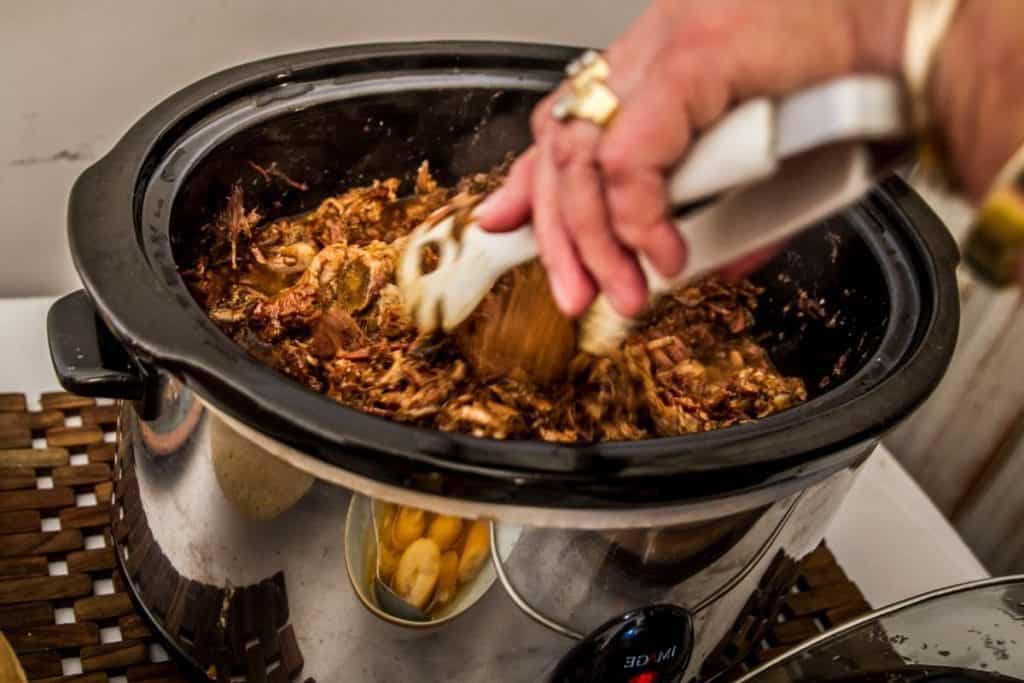
Cook time generally depends on the recipe and what ingredients you put inside the cooker. Most slow cooker recipes usually have a cooking time of 6 to 8 hours in low to medium heat settings. But you can definitely start prepping for the next day’s meal overnight, and it can be a great way to plan ahead of time.
But what foods can be left to cook for more extended hours without affecting the quality?
Rice and vegetables cook considerably faster, so leaving them on for too long could make them lose their texture and become too soggy or smushy. If you’re looking for a dish that can cook for longer hours, meat is your best option and can be left to cook for 10 to even 24 hours.
You can simmer chicken in a low heat setting for up to 10 hours and add your peppers and any other veggies 30 minutes before serving.
Pot roast, lamb shanks, pulled pork, and beef stew can be slow-cooked for 24 hours. These are perhaps the best dishes to set and forget and left to cook overnight.
Meats like beef, lamb, and pork become more tender the longer you cook, so this is your best option for a more extended cooking period.
And don’t forget about a deliciously juicy and tender crockpot turkey that can easily take 8-10 hours to cook or even longer if you are cooking a large bird. Just make sure you have a large enough size slow cooker for the job.
Also, many lentils like soybeans and kidney beans require long cooking times. It often takes 12 hours or more until they are perfectly tender and thoroughly cooked. Split peas, on the other hand, cook a lot faster – about 3 to 6 hours.
Read Also: 9 Best Slow Cooker Split Pea Soup Recipes With Ham And Potatoes.
In Summary
Leaving a slow cooker on overnight is generally safe, provided you follow certain safety guidelines. Modern slow cookers with timers offer an added layer of security, while even basic models are usually built for extended cooking times.
The key is to follow best practices like placing the cooker on a heat-resistant surface, not overloading it, and using appropriate settings. While the appliance itself is robust, the type of food you’re cooking and how you cook it plays a crucial role in safety and quality. Take proper precautions, and you can enjoy the convenience of slow cooking without worry.
Have easy and safe slow cooking!
